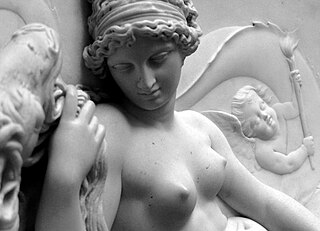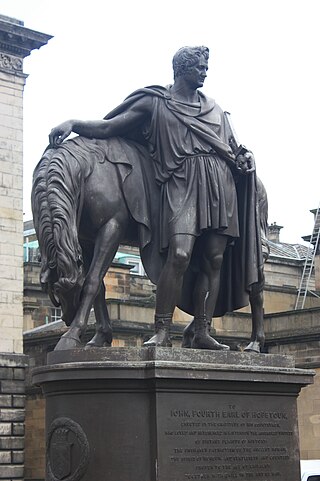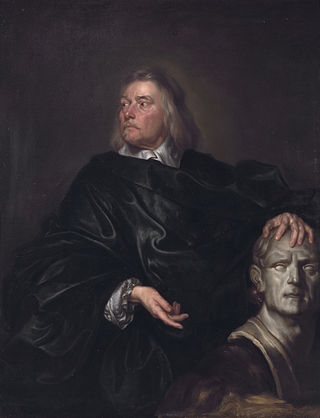
Michael Foye (also spelled as Michael Foy) was an eighteenth-century Irish sculptor. He is believed to have died in Rome around 1777.

Michael Foye (also spelled as Michael Foy) was an eighteenth-century Irish sculptor. He is believed to have died in Rome around 1777.
His name first appeared in Dublin in the year 1765 when he exhibited two works at the Dublin Society of Artists on William Street: "Venus and Cupid" in marble and "Group of Boys" in plaster. [1] In 1768 he presented "Mercury instructing Cupid" and in 1770 "Hercules Resting from his Labours". By 1769, he was working in the studio of John Nost III (nephew of the Dutch sculptor John Nost) who had come to Dublin in 1750.
In 1772, Foye undertook his grand tour and travelled to Italy arriving in Florence in April. In early 1773, he moved to Rome (living first in Strada dei Greci and then in Via Babuino). In 1773, he was mentioned by the English sculptor Thomas Banks, during Banks' own grand tour, as working on a sculpture of "Apollo del Belvedere" in marble. [2] In November 1776, the Welsh painter, Thomas Jones, mentioned a joint meeting in the Cafe degli Inglesi between himself, Foye, Thomas Banks, Christopher Hewetson and Nathaniel Marchant.
In 1777, Foye sent "Bust of an Artist" to the Society of Artists in London, which is generally thought to be the bust of Allan Ramsay, now held in the Scottish National Portrait Gallery. A second bust, originally believed to be of Sir William Hamilton (largely remembered now as the husband of Emma, Lady Hamilton), was later identified as Captain Sir John Lindsay. Lindsay was Ramsay's brother-in-law.
His only other known work is a carved relief of the artist James Durno which appeared in the sale of Thomas Banks' possessions in 1805.

Sir John Robert Steell was a Scottish sculptor. He modelled many of the leading figures of Scottish history and culture, and is best known for a number of sculptures displayed in Edinburgh, including the statue of Sir Walter Scott at the base of the Scott Monument.

Christopher Hewetson (c.1737–1798) was a neoclassical sculptor of portrait busts. Born in Ireland, he was active in Rome.

Giuseppe Ceracchi, also known as Giuseppe Cirachi, was an Italian sculptor active in a Neoclassic style. He worked in Italy, England, and in the United States following the nation's emergence following the American Revolutionary War.

John Cheere (1709–1787) was an English sculptor, born in London. The younger brother of the sculptor Sir Henry Cheere, he was originally apprenticed as a haberdasher from 1725 to 1732.

John Nost was a Flemish sculptor who worked in England in the late 17th and early 18th centuries.
Sir Henry Cheere, 1st Baronet was a renowned English sculptor and monumental mason. He was the older brother of John Cheere, also a notable sculptor.

George Bullock (c.1777–1818) was a sculptor and furniture-maker working in Liverpool and London.

John Deare was a British neo-classical sculptor. His nephew Joseph (1803–1835) was also a sculptor.
John Hickey (1751–1795) was an Irish sculptor.
Alfred Gatley was an English sculptor.

William Tyler was an English sculptor, landscaper, and architect, and one of the three founding members of the Royal Academy, in 1768. He was Director of the Society of Artists.

Edward Bowring Stephens, was a British sculptor from Devon. He was honorary secretary of the Institute of Sculptors circa 1861.

Patric Park was a Scottish sculptor.

Thomas Campbell was a Scottish sculptor in the early 19th century. He has several important public works, most notably a statue of Sarah Siddons in Westminster Abbey. He also has several works in the National Gallery in London. He was heavily patronised by the British aristocracy, as evidenced by his works.

Peter Turnerelli (c.1772–1839) was an Irish-born sculptor of Italian descent working in Britain in the early 19th century.

John van Nost the younger (1713-1780) was the nephew of the noted Flemish-born British sculptor John van Nost and a noteworthy sculptor in his own right.

Christopher Moore RHA MRIA MRHA (1790–1863) was an Irish-born sculptor operational mainly in England in the 19th century.
Terence Farrell was an Irish sculptor, now best known for his portrait busts and works at Wrest Park for Earl de Grey.

Edward Pierce or Pearce (1630–1695) was a 17th century English sculptor and architectural sculptor. He was also an avid collector of books, drawings and plaster figures.
James Heffernan was an 18th/19th century Irish-born sculptor, later based in London.